SPECIAL COVERAGE >> Daily Specials
Inside look at Chinese traditional burial culture
Chinese traditionally believe that souls may rest in peace only if their bodies are properly buried underground in coffins. But today, many are becoming open to other options, such as scattering ashes in the sea or inlaying funeral urns in walls, according to Xinhua News Agency.
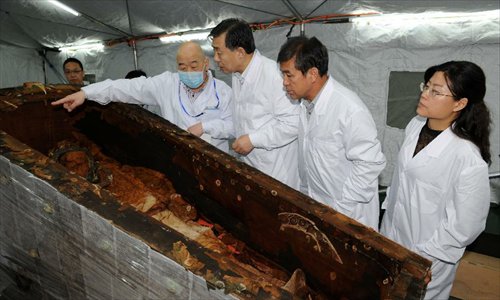
Archaeologists check the inside of an unearthed coffin after they open it at Xilin Gol league museum in Xilin Hot, North China's Inner Mongolia Autonomous Region, March 8, 2014. A 1,500-year-old coffin, excavated from the grasslands of Xilin Gol, was opened on March 8. The well-preserved coffin could date back to Northern Wei Dynasty (386-534). The identity of the tomb's owner is still unknown. (Xinhua/Zhang Ling)
| According to Chinese folk beliefs, man is made from earth, and should return to it upon death. Some of the earliest tomb burials can be traced back to the Xiongnu, an ancient Eurasian nomadic tribe that traveled across northern China. The Miao ethnic minority is another early group that practiced tomb burials. Since Neolithic times, ancient Chinese were buried with artifacts and other funerary objects befitting their social status. Some tombs included human sacrifices, such as concubines and servants. Wealthy or privileged families would construct elaborate underground complexes for the deceased. Today, tomb burials are mainly allowed to be practiced among Chinese ethnic minorities and in areas without crematoriums. |
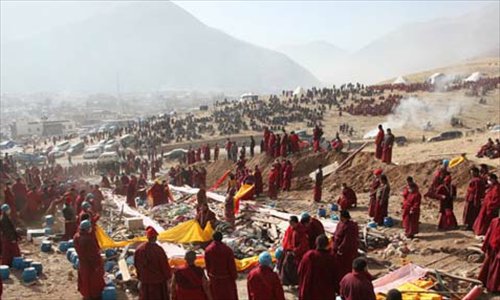
Monks gather to pray over remains which are to be cremated. Photo: wmgm.org
Cremation is the most traditional funerary practice in China, and the most modern. First practiced among ethnic minorities, nomadic tribes would conveniently carry the remains of their dead in urns. The practice later popularized with the spread of Buddhism. However, as the burning of human remains ran contrary to established Confucian practice, it was eventually banned during the Ming (1368-1644) and Qing Dynasty (1644-1911). Today with the rising costs of cemetery plots and space for earth burials, Chinese authorities advocate cremation for its low cost and high level of hygiene.
But according to Regulations on Funeral and Interment Control, cremation is not practised in areas where there are no requisite conditions for cremation and in areas inhabited with ethnic minorites who have their own funeral and interment customs, which should be respected. |
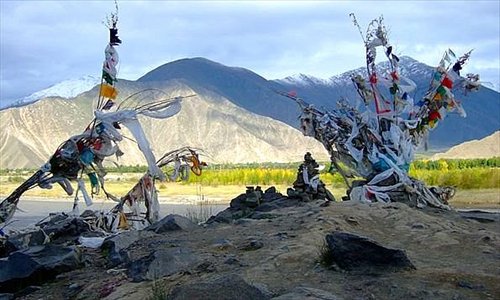
A ceremonial water burial site Photo: wmgm.org
| Water burials are practiced exclusively in Southwest China’s Tibet Autonomous Region and environs. Traditionally, a Buddhist lama determines the most appropriate date to conduct the water burial, which involves releasing the remains (sometimes dismembered) into a local river. The lama will preside over the ritual and chant prayers for the departed. In parts of Sichuan and Yunnan provinces, water burials are held for those who die of infectious disease or victims of homicide. In most cases, the government discourages water burials as they are harmful to the environment. |
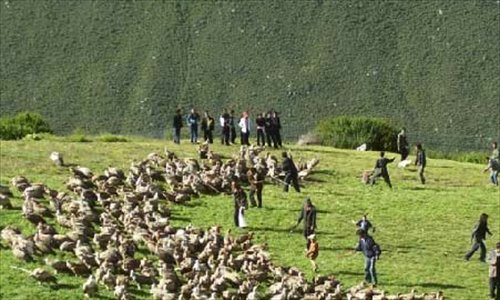
Sky burial site Photo: ifeng.com
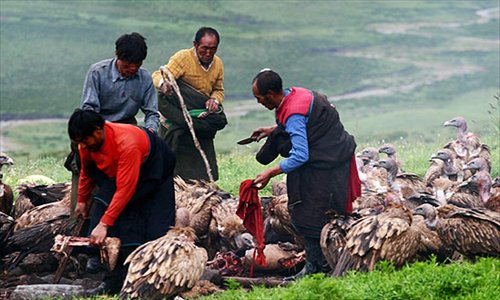
Vultures gather as locals prepare a sky burial site. Photo: wmgm.org
| Characteristic among Tibetan minorities throughout western China, sky burials are a Vajrayana Buddhist practice that involves placing a prepared human corpse high on a mountain and leaving it exposed to the elements and animals, such as vultures and other predatory birds. Some who practice the ritual believe that the birds eat the remains and return the spirit of the departed to the sky. At the same time, the sky burial also functions as a way of giving back to nature, an important part of Buddhist practice. They also prove to be practical, as wood for coffins or cremation pyres is scarce on the Tibetan plateau. Originally reserved for high lamas and other religious dignitaries, sky burials are now conducted to dispose of the corpses of commoners. However, it is not considered suitable for children under 18 years old, pregnant women, or those who have died of infectious diseases or accidental deaths. |
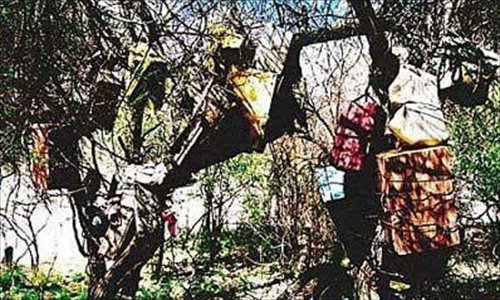
Several small coffins hang from trees. Photo: civilization.kexue.com
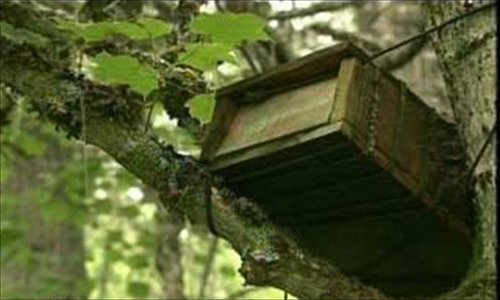
A coffin rests in branches as part of a tree burial. Photo: civilization.kexue.com
| Still a prevailing practice in the Nyingchi Prefecture of Tibet Autonomous Region, tree burials are usually conducted for children. The bodies are washed with salt water and placed in coffins or bamboo baskets and hung on trees. It is believed by doing so that families can avoid the same misfortune befalling their other children, according to china.com.cn. |
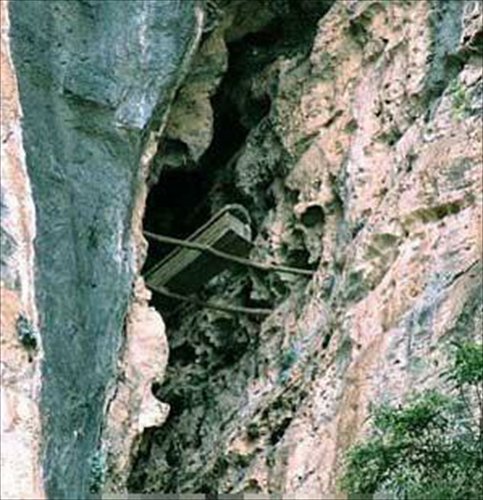
A wooden casket rests on support beams between two cliff walls. Photo: civilization.kexue.com
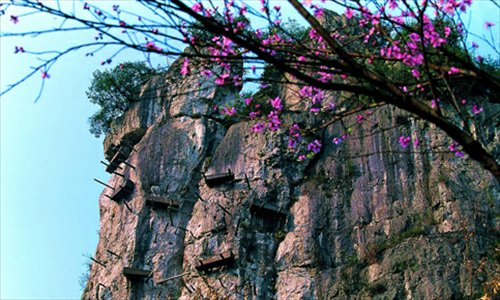
Several wooden caskets rest on protruding poles on a cliff. Photo: sichuan.scol.com.cn
| Cliff burial is common among the ethnic groups in southwestern China. Bodies are embalmed with ghee (a kind of butter), salt and perfumes and placed in a wooden coffin. The casket is then transported to a natural or man-made cliffside cave and placed beside other remains. The elevation of the cave is determined by social status, according to china.com.cn. |
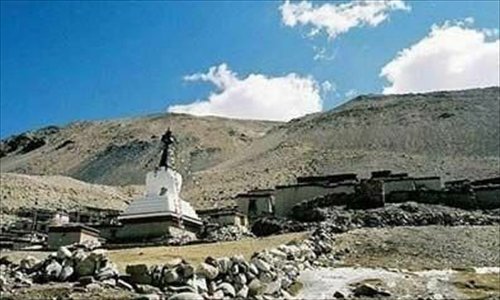
A stupa site Photo: wmgm.org
| Stupa burials are reserved for those of the highest status among the Tibet ethnic group, such as high lamas. The body is first cleaned with salt water and then doused with precious ointments and perfumes before being placed in the stupa. In some cases, cremation ashes are housed in a stupa. Built near monastery halls, the appearance of stupas varies depending on the rank of its occupant. |
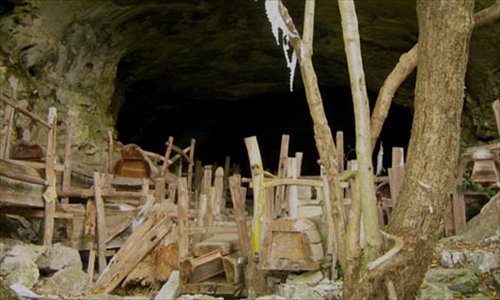
Coffins housed in a large cave Photo: traditions.cultural-china.com
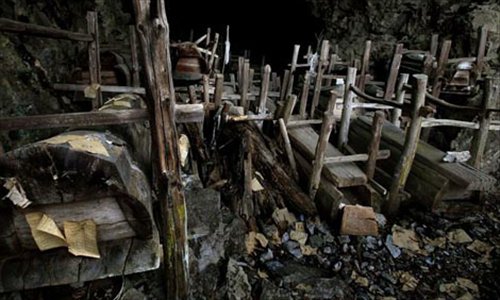
Coffins housed in a large cave Photo: traditions.cultural-china.com
| According to Miao tradition, those of high status who pass away are placed in a coffin and carried to a large cave. Their position in the cave depends on seniority in his or her family or clan, the Xinhua News Agency reported. |
With land resources running scarce, authorities across the country are promoting relatively non-traditional funerary methods, such as scattering of ashes into the sea or burying them under trees or flower, as a way to conserve land space, according to Xinhua.
Web editor: gelili@globaltimes.com.cn











